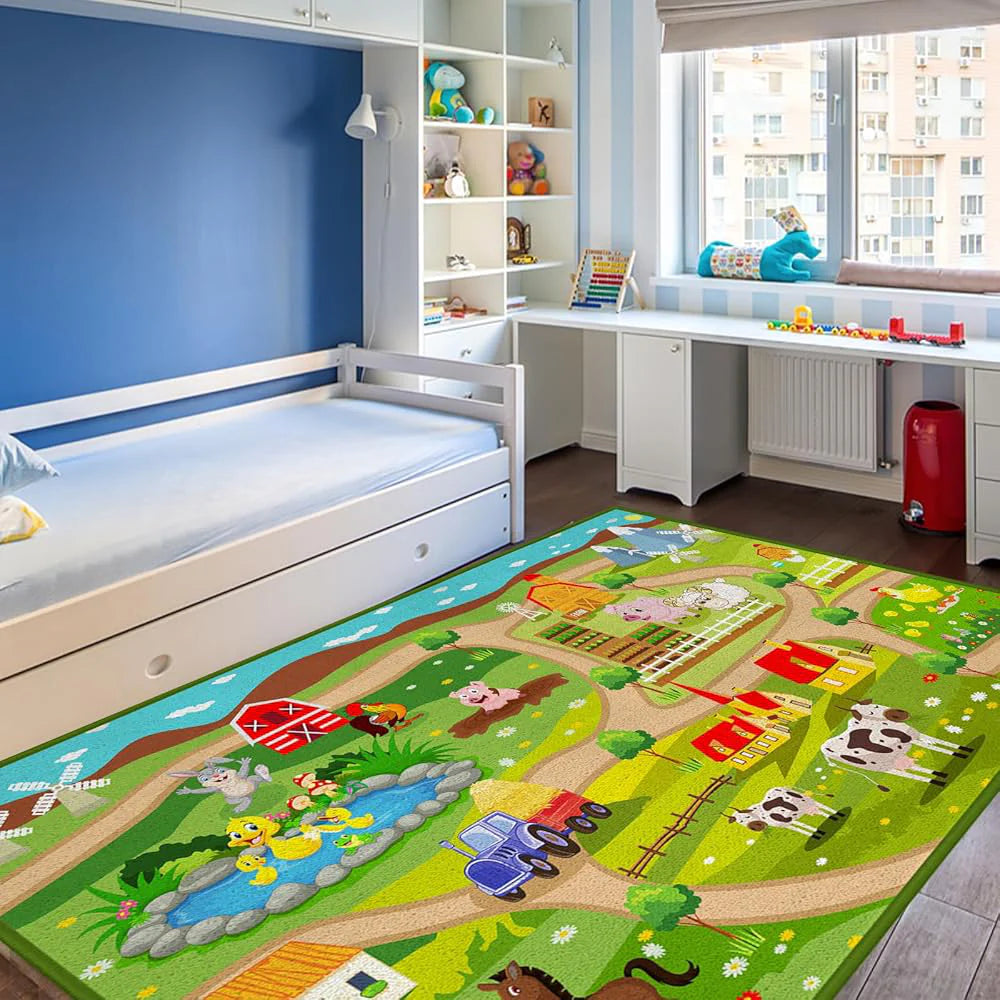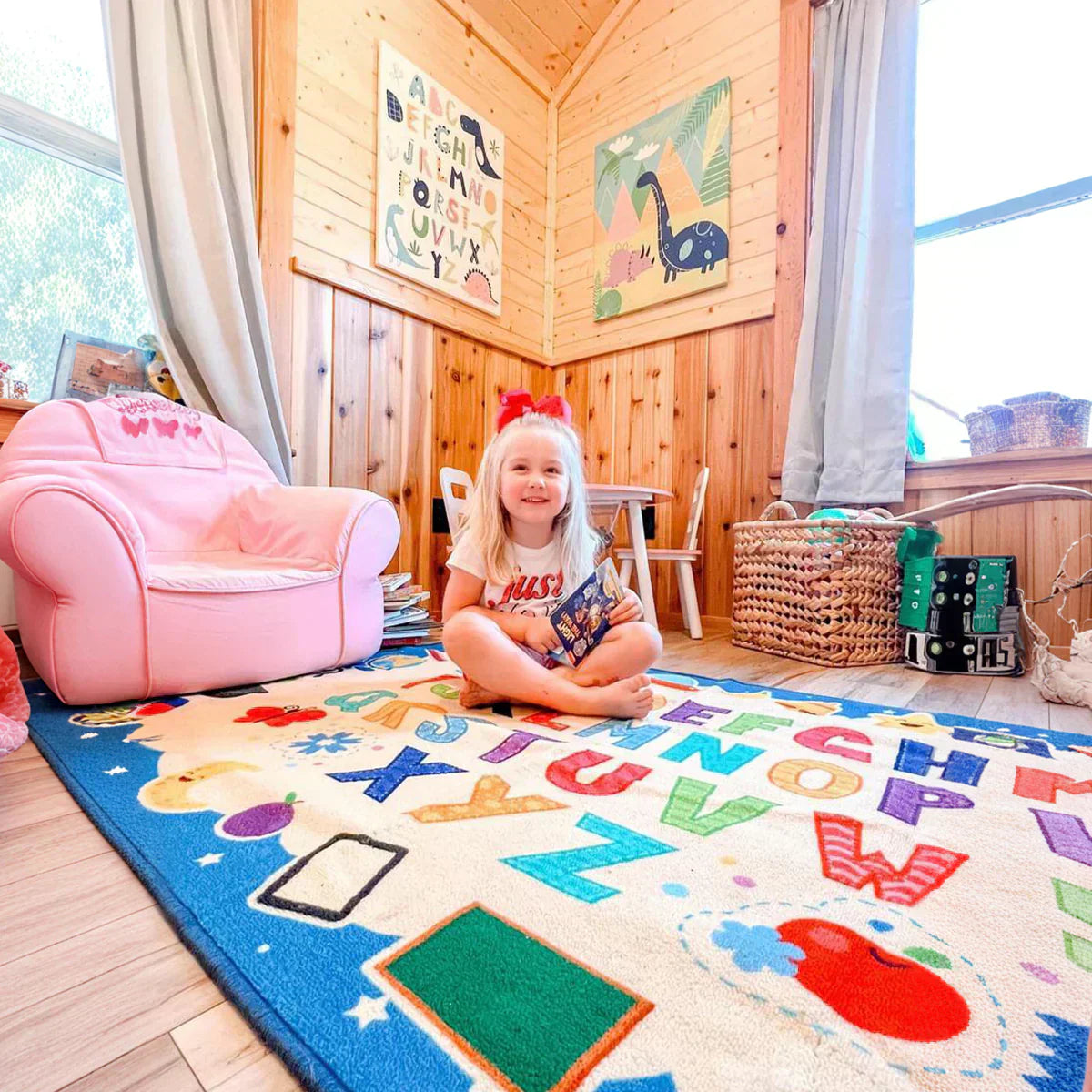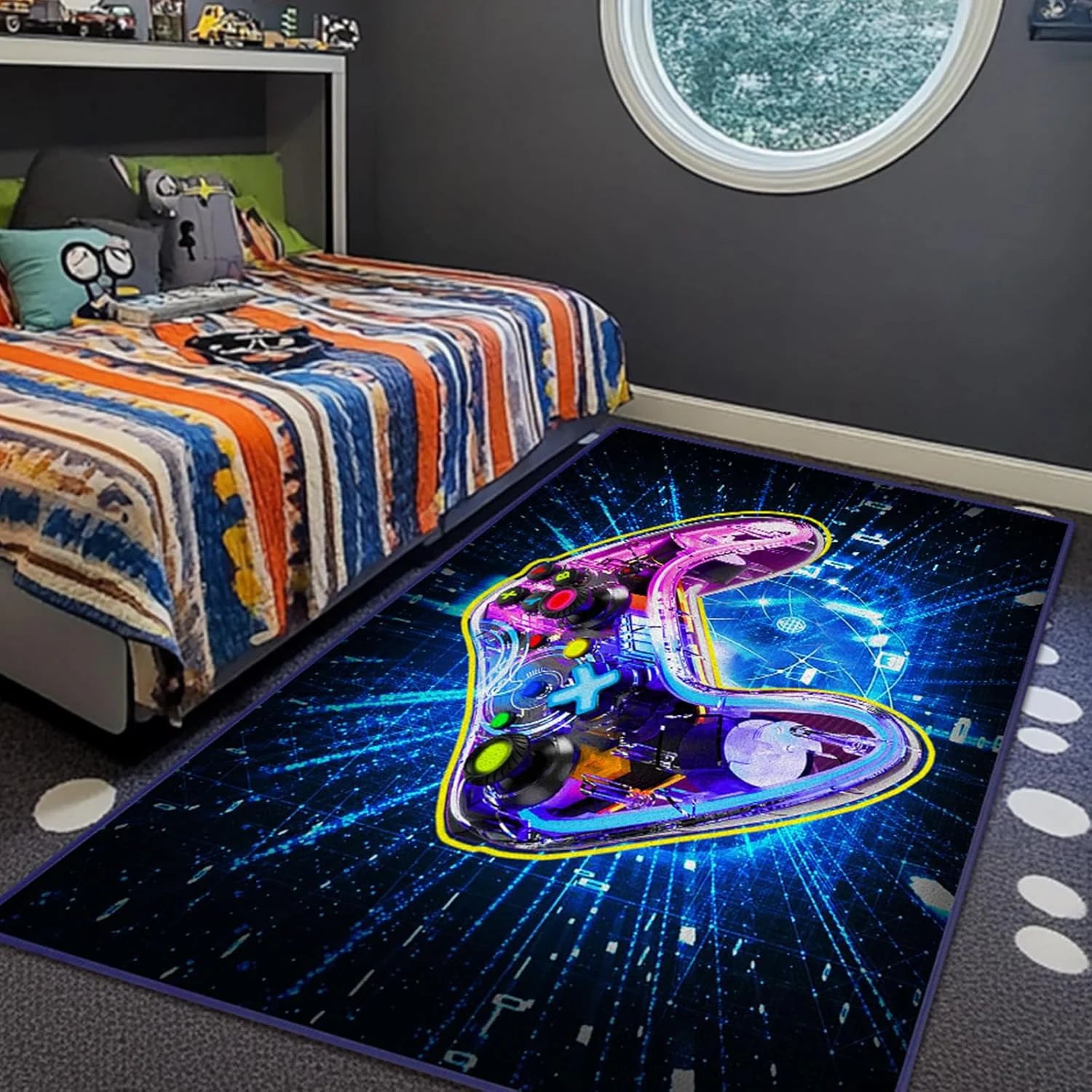Why Strategic Rug Placement Matters in Children's Spaces
Proper rug placement in children's environments serves multiple critical functions beyond simple decoration. Research shows that well-positioned rugs can improve spatial awareness, create defined learning zones, enhance safety, and support cognitive development through environmental organization.
Key Benefits of Strategic Rug Placement:
- Safety Enhancement: Proper positioning reduces slip hazards and provides cushioned landing areas
- Zone Definition: Creates distinct areas for different activities (sleep, play, study, quiet time)
- Acoustic Improvement: Reduces noise levels and echo, especially important in active play areas
- Floor Protection: Shields flooring from scratches, spills, and high-traffic wear
- Sensory Support: Provides tactile stimulation and comfort for barefoot activities
2025 Placement Trends: Current trends emphasize creating multifunctional zones within children's spaces. Divide the room into different zones for sleeping, changing, and playing by using rugs or furniture to outline them. This approach helps children understand spatial boundaries while maximizing room functionality.
Essential Safety Considerations for Rug Placement
Before exploring specific placement strategies, safety must be your top priority when positioning rugs in children's spaces.
Critical Safety Guidelines:
- Slip Prevention: Always use slip-resistant backing or high-quality rug pads to prevent sliding
- Trip Hazard Elimination: Ensure rug edges lie flat and avoid high-pile rugs in high-traffic areas
- Emergency Access: Maintain clear pathways to doors and windows for emergency situations
- Furniture Stability: Avoid placements that could cause furniture to become unbalanced
- Visibility: Ensure rugs don't obscure important safety features or create blind spots
Material Safety for Child Spaces: Our rugs are hypoallergenic and resist dust mites, mold, and mildew—perfect for kids with allergies or asthma. The weighted bottom increases slip resistance by 80%, making them ideal for high-traffic game rooms or busy classrooms.
Children's Bedroom Rug Placement: Creating Comfort Zones
Bedrooms serve as children's personal sanctuaries, requiring thoughtful rug placement that supports both rest and play activities.
Primary Bedroom Placement Options
1. Under-the-Bed Placement (Most Popular) Position the rug so it extends 18-24 inches beyond each side of the bed and at the foot. This creates a soft, cushioned landing when your child gets up each morning.
Sizing Guidelines:
- Twin/Single Bed: Minimum 5' x 8' rug
- Double/Full Bed: Minimum 6' x 9' rug
- Queen Bed: Minimum 8' x 10' rug
- Bunk Beds: Two 4' x 6' rugs or one large 8' x 10' rug
2. Partial Under-Bed Placement For smaller rugs or larger beds, place the rug partially under the bed, leaving some exposed at the foot. This works well with 6' x 9' rugs under queen beds or when budget constraints limit rug size.
3. Bedside Runner Configuration
Use two matching runners (2.5' x 8' or 3' x 8') placed parallel to each side of the bed. This option works excellently when both sides of the bed are accessible and provides symmetrical comfort.
4. Zone-Defining Placement Use multiple smaller rugs to create distinct zones within the bedroom:
- Sleep Zone: Large rug under bed
- Play Area: Medium rug (5' x 7') in corner for toys and activities
- Reading Nook: Small round rug (4' diameter) with comfortable seating
Age-Specific Bedroom Considerations
Toddlers (Ages 2-4):
- Prioritize soft, cushioned surfaces for frequent falls
- Use educational rugs with alphabet, numbers, or shape patterns
- Ensure easy-clean materials for potty training accidents
- Consider washable options for maximum hygiene
School-Age Children (Ages 5-12):
- Create homework zones with dedicated rug areas
- Balance comfort with durability for increased activity
- Allow children input in placement decisions for ownership
- Plan for furniture growth and room layout changes
Teenagers (Ages 13+):
- Focus on style and personal expression
- Create distinct zones for sleep, study, and socializing
- Consider layering rugs for visual interest
- Prioritize easy maintenance for busy schedules
Playroom Rug Placement: Maximizing Fun and Function
Playrooms require the most strategic rug placement due to intense activity levels and diverse functional needs.
Central Play Area Configuration
Large Area Rug Strategy: Position a large rug (8' x 10' or 9' x 12') in the center of the room, leaving 18-24 inches of bare floor around the perimeter. This creates a defined play zone while maintaining clear walkways.
Benefits:
- Protects underlying flooring from toy impacts
- Provides comfortable surface for floor play
- Creates visual boundaries for activity areas
- Reduces noise transfer to rooms below
Activity-Specific Zones:
- Building/Construction Zone: Firm, low-pile rug for LEGO and block building
- Art/Craft Area: Easy-clean, stain-resistant surface near creative supplies
- Reading Corner: Soft, plush rug with comfortable texture for story time
- Active Play Zone: Durable rug that can withstand jumping and rough play
Multi-Zone Playroom Layout
For larger playrooms, use multiple rugs to create distinct activity areas:
Zone 1: Quiet Activities (4' x 6' rug)
- Puzzles, reading, drawing
- Soft textures for comfort
- Calming colors to promote focus
Zone 2: Active Play (6' x 9' rug)
- Dancing, exercise, physical games
- Durable, slip-resistant materials
- Bright, energizing colors
Zone 3: Building/Construction (5' x 7' rug)
- LEGO, blocks, train sets
- Firm surface with defined edges
- Pattern that aids in organization
Traffic Flow Considerations:
- Maintain 36-inch pathways between zones
- Ensure clear sightlines across the room
- Position rugs to guide natural movement patterns
- Avoid creating trip hazards at zone transitions
Additional Areas Where Soft Surfaces Benefit Children
Beyond bedrooms and playrooms, strategic rug placement enhances many other areas where children spend time.
Nursery Spaces
Under Changing Station: Place a 3' x 5' rug under the changing table for comfort during diaper changes and to protect flooring from spills.
Feeding Area: Position a washable rug under the high chair or nursing chair. Choose stain-resistant materials for easy cleanup of inevitable spills.
Tummy Time Zone: Create a dedicated area with an extra-soft, hypoallergenic rug for infant floor activities. Ensure the rug is large enough (minimum 4' x 6') for safe movement.
Homework and Study Areas
Desk Area Placement: Position a rug under the desk and chair, extending 18 inches beyond the chair's maximum pull-out distance. This reduces noise and provides comfort for feet during long study sessions.
Reading Nooks: Create cozy reading spaces with small, round rugs (4' diameter) paired with comfortable seating. Choose calming colors that promote concentration.
Bathroom Considerations
Safety-First Approach:
- Use only bathroom-specific, quick-dry rugs
- Ensure excellent slip resistance
- Choose antimicrobial materials
- Position away from direct shower spray
- Maintain easy access to all fixtures
Kitchen and Dining Areas
High Chair Zone: Place washable rugs under high chairs and eating areas. Choose materials that can withstand daily cleaning and food spills.
Cooking Activity Area: For children who help with cooking, provide a cushioned standing surface with easy-clean properties near the counter.
Size and Shape Guidelines for Different Spaces
Proper sizing ensures optimal function and visual appeal in children's spaces.
Room Size Calculations
General Rule: Your child's rug should be at least two feet (60cm) shorter than the width and length of the room to maintain proper proportions.
Small Rooms (Under 100 sq ft):
- One medium rug (5' x 7' or 6' x 8')
- Avoid multiple rugs that fragment the space
- Light colors to enhance spaciousness
Medium Rooms (100-150 sq ft):
- Large central rug (8' x 10') or multiple coordinated rugs
- Allow for distinct activity zones
- Balance open floor space with covered areas
Large Rooms (Over 150 sq ft):
- Multiple rugs for different zones
- Consider rug runners for connecting spaces
- Layer different sizes for visual interest
Shape Selection Strategy
Rectangular Rugs:
- Most versatile for furniture arrangement
- Ideal for under beds and in formal spaces
- Works well in longer, narrower rooms
Round Rugs:
- Softens sharp room corners
- Perfect for reading nooks and play circles
- Creates intimate gathering spaces
- Often appears larger than actual size
Custom Shapes:
- Educational shapes (letters, numbers, animals)
- Activity-specific designs (roads, hopscotch)
- Personality-driven choices (stars, flowers, clouds)
2025 Design Trends in Children's Rug Placement
Current design trends emphasize flexibility, sustainability, and multi-functionality in children's spaces.
Trend 1: Zoning with Color Coordination
Concept: Use different colored rugs to define activity zones while maintaining visual cohesion through coordinated color palettes.
Implementation:
- Soft blue for quiet/sleep areas
- Energizing yellow for active play zones
- Green for learning/study spaces
- Neutral tones for transition areas
Trend 2: Layering for Visual Interest
Concept: Layer smaller rugs over larger base rugs to create depth and allow for easy updates as children's tastes change.
Benefits:
- Cost-effective way to change room aesthetics
- Protects investment in larger base rugs
- Allows seasonal or thematic updates
- Creates visual complexity and interest
Trend 3: Nature-Inspired Placement
Concept: Earthy colours are surging in popularity—sage green, dusty blue and terracotta create calming, grounded atmospheres.
Application:
- Natural fiber rugs in irregular, organic shapes
- Placement that mimics natural landscapes
- Integration with plants and natural lighting
- Earth-tone color palettes throughout the space
Trend 4: Technology Integration Zones
Concept: Create dedicated areas for screen time and digital learning with appropriate rug placement.
Considerations:
- Anti-static materials near electronics
- Easy-clean surfaces for snack areas
- Proper ergonomic support for seated activities
- Defined boundaries to limit screen time areas
Common Placement Mistakes to Avoid
Learning from common errors helps ensure optimal rug placement in children's spaces.
Size-Related Mistakes
Too Small: Rugs that appear to "float" in the room or don't accommodate furniture properly create visual imbalance and reduced functionality.
Too Large: Overwhelming rugs that leave less than 12 inches of floor space around edges can make rooms feel cramped.
Wrong Proportions: Mismatched rug sizes in multi-rug arrangements create visual chaos rather than intentional design.
Safety Oversights
Inadequate Anchoring: Rugs without proper backing or padding create trip hazards and slide during active play.
Blocked Pathways: Placement that impedes natural traffic flow or emergency exit routes compromises safety.
Height Variations: Significant thickness differences between adjacent rugs create tripping hazards.
Functional Errors
Activity Mismatch: Placing delicate rugs in high-activity areas or choosing inappropriate materials for specific functions.
Maintenance Neglect: Failing to consider cleaning access and requirements when positioning rugs in children's spaces.
Growth Planning: Not considering how placement needs will change as children grow and room functions evolve.
Maintenance and Care for Placed Rugs
Proper maintenance strategies vary based on rug placement and usage patterns.
High-Traffic Area Care
Daily Maintenance:
- Quick vacuum or sweep to remove debris
- Immediate spot cleaning of spills
- Visual inspection for safety hazards
- Rug pad adjustment if needed
Weekly Deep Care:
- Thorough vacuuming with appropriate settings
- Edge cleaning and straightening
- Rotation to prevent uneven wear
- Professional assessment of high-wear areas
Specialized Area Considerations
Eating Areas:
- Use protective mats during meal times
- Clean spills immediately to prevent staining
- Choose materials that resist odor absorption
- Consider professional cleaning monthly
Play Zones:
- Regular sanitization, especially during illness seasons
- Toy debris removal to prevent damage
- Check for loose fibers that could pose choking hazards
- Monitor for signs of excessive wear
Budget-Friendly Placement Strategies
Creating beautiful, functional spaces doesn't require unlimited budgets.
Phased Implementation
Phase 1: Essential Areas Start with the most critical placements:
- Primary rug under bed
- Safety rug in main play area
- Non-slip bath mat for bathroom safety
Phase 2: Comfort Additions Add rugs for enhanced comfort:
- Reading nook rug
- Bedside runners
- Desk area rug
Phase 3: Aesthetic Enhancements Complete the design with finishing touches:
- Decorative accent rugs
- Seasonal layering pieces
- Theme-specific designs
Cost-Effective Solutions
Rug Pad Investment: High-quality rug pads extend rug life and improve safety, making them worth the investment.
Washable Options: Choose washable rugs for high-mess areas to reduce professional cleaning costs.
Multi-Functional Designs: Select rugs that serve multiple purposes (play surface, learning tool, comfort zone).
Size Strategy: One well-placed large rug often works better than multiple small rugs and can be more cost-effective.
Special Considerations for Different Family Situations
Every family has unique needs that affect optimal rug placement strategies.
Shared Bedrooms
Twin Configuration:
- Place rug between beds to create shared space
- Use two identical runners under each bed
- Consider L-shaped placement for corner beds
Bunk Bed Arrangements:
- Large rug under entire bunk structure
- Safety padding around ladder area
- Clear pathways for top bunk access
Children with Special Needs
Sensory Considerations:
- Texture variety for sensory input
- Calm colors in overstimulation-prone areas
- Clear visual boundaries for spatial awareness
- Easy-clean materials for medical needs
Mobility Accommodations:
- Low-profile rugs for wheelchair access
- Non-slip surfaces for stability
- Clear pathways for mobility equipment
- Cushioned areas for physical therapy
Pet-Friendly Households
Material Selection:
- Choose pet-hair resistant fibers
- Stain-resistant treatments for accidents
- Durable construction for pet play
- Easy-clean surfaces for hygiene
Placement Strategy:
- Avoid areas where pets eat or drink
- Consider pet traffic patterns
- Protect rugs during pet training periods
Creating Flexible Spaces That Grow with Children
Design rug placement strategies that adapt to changing needs over time.
Modular Approach
Concept: Use multiple smaller rugs that can be reconfigured as needs change.
Benefits:
- Easy to move and rearrange
- Replace individual pieces instead of entire rugs
- Adapt to different furniture configurations
- Budget-friendly updates over time
Timeless Placement Principles
Focus on Function: Choose placements based on room function rather than current trends.
Quality Investment: Invest in high-quality rugs for permanent placements, use less expensive options for changeable areas.
Neutral Foundations: Use neutral colors and patterns for large rugs, add personality with smaller accent pieces.
Conclusion: Creating Safe, Beautiful, Functional Spaces
Strategic rug placement in children's spaces requires balancing safety, functionality, comfort, and aesthetics. By understanding proper sizing, considering age-appropriate needs, and planning for future changes, you can create environments that support your child's development while providing years of enjoyment.
Remember that the best rug placement is one that makes your child's space more comfortable, safer, and more enjoyable to use. Whether you're creating a cozy bedroom retreat, an energetic playroom, or a calm study area, thoughtful rug placement transforms ordinary spaces into extraordinary environments where children can thrive.
At Booooom Jackson, we're committed to providing rugs that not only meet the highest safety standards but also support optimal placement strategies for maximum benefit. Our durable nylon fibers resist fading, reinforced edges prevent fraying, and weighted bottoms provide superior slip resistance—all designed to perform beautifully wherever you choose to place them in your child's world.
Ready to transform your child's space? Explore our collection of safety-certified rugs designed for optimal placement in bedrooms, playrooms, and beyond. From educational designs to comfort-focused materials, we have the perfect rug for every space and every child's unique needs.
External Resources:




Leave a comment
This site is protected by hCaptcha and the hCaptcha Privacy Policy and Terms of Service apply.